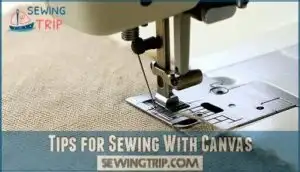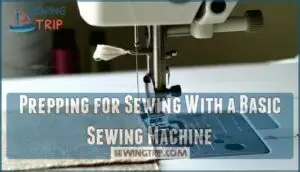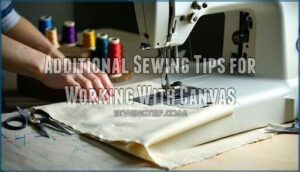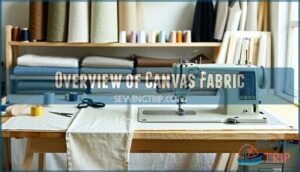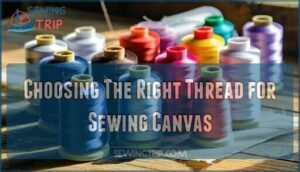This site is supported by our readers. We may earn a commission, at no cost to you, if you purchase through links.
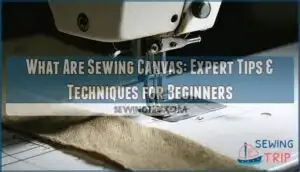
You’ll need a heavy-duty needle (size 16-18), strong polyester thread, and a sturdy sewing machine to handle canvas’s thickness.
Canvas comes in various weights – lighter canvas works for clothing while heavyweight canvas suits industrial applications.
The fabric’s tight weave makes it tear-resistant but challenging to sew through multiple layers.
You’ll want to adjust your stitch length to accommodate the fabric’s density and use a walking foot for even feeding.
Canvas doesn’t fray easily, which simplifies finishing techniques.
Understanding these fundamentals transforms intimidating canvas projects into manageable creations with professional results.
Table Of Contents
Key Takeaways
- You’ll need heavy-duty equipment – Use size 16-18 needles, polyester thread, and a walking foot attachment to handle canvas’s thick, tightly woven structure without breaking your machine or creating frustrating sewing experiences.
- Canvas weight determines your project’s success – Choose medium-weight canvas (8-12 oz) for beginners since it’s forgiving yet sturdy, while heavyweight canvas suits industrial applications but requires more advanced techniques.
- Proper machine settings prevent common problems – Set your stitch length to 3.5-4mm and adjust tension around setting 4 to avoid puckering, skipped stitches, and thread breaks on thick canvas layers.
- You can sew canvas on regular machines with modifications – Most home sewing machines handle canvas when you install the right needle, use clips instead of pins, and test your settings on scraps before starting your actual project.
What is Canvas Material?
Canvas material stands as the workhorse of heavyduty fabric options.
Canvas delivers unmatched durability when you need fabric that works as hard as you do.
This plain-weave textile features thick yarns interlaced in a simple over-under pattern, creating exceptional canvas durability.
Canvas origins trace back to hemp fibers, though modern canvas primarily uses cotton threads.
The fabric weave produces a low thread count of 50-100, balancing strength with workability.
Canvas weight varies from lightweight duck to heavy industrial grades.
Different canvas fabric types serve specific purposes – cotton canvas offers versatility, while linen provides superior strength.
The material’s canvas absorbency allows it to hold 27 times its weight in water while maintaining breathability.
Canvas holds 27 times its weight in water yet still breathes—nature’s perfect balance of absorption and airflow.
When sewing canvas fabric, you’ll appreciate its structural rigidity and minimal stretch, making it ideal for projects requiring shape retention.
Tips for Sewing With Canvas
Working with canvas requires specific techniques to handle its thick, sturdy nature effectively.
You’ll need the right tools and methods to achieve professional results without damaging your machine or creating frustrating sewing experiences.
Choosing The Right Needles for Canvas
When tackling heavyweight canvas fabric, your needle selection makes the difference between smooth sailing and frustrating breakage.
Heavy-duty needles in sizes 100/16 to 110/18 penetrate thick layers without bending. Jeans needles feature reinforced shafts perfect for canvas, while leather needles slice through but leave visible holes.
For the best results with heavy canvas, consider using bonded nylon thread. Test different needle types on scraps first—proper needle selection prevents skipped stitches and thread breaks.
Selecting The Appropriate Thread for Canvas
After selecting the right needle, your thread choice makes or breaks your canvas project.
For heavy canvas, bonded polyester thread offers superior UV resistance and durability compared to cotton alternatives. Cotton-wrapped polyester thread provides a softer finish while maintaining strength.
Match thread weight to fabric thickness—Tex 70 works well for most canvas projects. Durable thread prevents seam failure, while proper color matching creates professional results.
For boat canvas, consider how thread impacts durability.
Stitch Length and Tension for Sewing Canvas
Two key settings make or break your sewing canvas success: ideal length and proper tension. Set your stitch length between 3.5-4mm for canvas—this prevents puckering while creating durable seams that won’t fail under stress.
Your sewing machine tension should start around 4, but don’t be afraid to adjust based on your specific canvas weight and thread choice.
- Ideal Length: Use 3.5-4mm stitch length to handle canvas thickness without creating wobbly stitches
- Tension Troubleshooting: Start at setting 4, then adjust up or down based on thread performance and fabric response
- Preventing Puckering: Longer stitches reduce fabric bunching and create smoother seams on heavy canvas
- Reinforcement Stitching: Consider double-stitching high-stress areas for maximum seam durability
Test these settings on canvas scraps first—your future self will thank you.
Using Clips and Tape for Fabric Stability
Securing your canvas layers prevents shifting and bunching during sewing canvas projects.
Heavy-duty clips grip thick layered canvas better than pins, while doublesided tape holds edges firmly in place.
- Heavy-duty sewing clips – Grip multiple canvas layers without fabric damage or slipping
- Fusible stay tape – Reinforces high-stress seams and prevents stretching in industrial applications
- Basting tape – Temporarily holds folded hems and securing curves without permanent adhesion
- Pattern weights – Keep large canvas pieces flat and aligned during cutting and marking
These clip types and tape alternatives guarantee fabric stability for professional results.
Ironing and Pressing Techniques for Canvas
Proper fabric preparation transforms your canvas fabric from stiff material into workable fabric. You’ll need consistent heat levels and steam settings to achieve professional results without damaging the fibers.
A vital step involves using the correct needle sizes to prevent damage.
| Ironing Tools | Heat Levels | Steam Settings |
|---|---|---|
| Cotton setting | Medium-high heat | Full steam power |
| Press cloth | Linen temperature | Burst steam option |
| Iron soleplate | 375-400°F range | Variable steam control |
| Pressing board | Consistent heat | Steam reservoir full |
| Spray bottle | Temperature gauge | Steam vents clear |
Start wrinkle removal on the fabric’s wrong side, using seam pressing techniques for crisp edges. These sewing techniques guarantee your sewing tips deliver smooth canvas that feeds evenly through your machine.
How to Sew Canvas
You’ll need the right setup and techniques to successfully sew canvas fabric on your machine.
This section covers machine preparation, essential sewing tips, and professional finishing methods that’ll help you complete your canvas projects with confidence.
Prepping for Sewing With a Basic Sewing Machine
Getting your basic sewing machine ready for canvas fabric doesn’t require a complete overhaul. Start with these machine limitations in mind – regular machines can handle canvas with proper needle compatibility and thread selection.
Install a size 16 or 18 denim needle designed for thick fabrics. These heavy-duty needles punch through canvas without breaking or creating jagged holes. Next, load your machine with polyester thread, which offers superior strength compared to cotton alternatives.
Adjust your tension settings slightly looser than normal to accommodate the thick canvas fabric. Test these tension adjustments on scrap material first. Proper fabric handling begins with a walking foot attachment, which feeds canvas evenly and prevents bunching. To guarantee durability, consider using heavy-duty polyester thread.
- Test your setup – Always run a practice seam on canvas scraps before starting your actual project to guarantee smooth operation.
Additional Sewing Tips for Working With Canvas
Beyond your basic machine setup, mastering canvas requires smart workarounds for this stubborn fabric. Canvas doesn’t always play nice, but these sewing canvas techniques will help you tackle common canvas sewing challenges.
When working with multiple layers, clips work better than pins for layer management. They won’t leave holes and grip thick canvas securely. For seam reinforcement, backstitch at stress points like bag handles or pocket corners. Your machine maintenance becomes critical—clean out canvas fibers regularly to prevent jamming.
Pattern adjustments often become necessary since canvas doesn’t drape like lighter fabrics. Add extra ease where needed. For edge finishing, a zigzag stitch prevents fraying better than pinking shears on canvas’s loose weave.
Here are key sewing solutions for canvas projects:
- Use a walking foot to prevent fabric shifting
- Grade seam allowances to reduce bulk
- Clip curves every 1/8 inch for smooth turns
- Apply spray starch for easier handling
- Test all settings on scraps first
These canvas sewing tutorials techniques will transform your challenging canvas projects into successful creations.
Finishing Touches for Canvas Projects
Why settle for average when professional finishing touches transform your canvas sewing projects?
Start with seam reinforcement at stress points using bar tacks or extra stitching lines. Apply edge finishing techniques like bias tape binding or zigzag hemming to prevent fraying.
Hardware application requires precise placement—use rivets or heavy-duty snaps for durability. Consider stain protection treatments for outdoor canvas projects.
Proper canvas care includes pressing seams flat and trimming excess threads. These canvas sewing techniques guarantee your tutorials deliver professional results every time, with the right finishing touches.
Can I Hand Sew Canvas? How to Sew Canvas by Hand
While machine sewing offers speed and efficiency, hand sewing canvas fabric provides unmatched control and precision for detailed work.
You’ll need specialized tools and techniques to handle canvas thickness effectively.
Hand stitching canvas requires proper needle selection and thread choices.
Sailmaker’s needles or leather needles pierce thick fibers without bending.
Heavy-duty polyester or nylon thread withstands stress better than cotton alternatives.
Canvas sewing demands patience since the material’s density slows progress compared to lighter fabrics.
For ideal results, consider using heavy-duty polyester thread for added durability.
Essential hand sewing techniques for canvas include:
- Awl Techniques – Pre-punch holes to reduce fabric strain and create cleaner stitches
- Thimble Use – Protect fingers while pushing needles through multiple canvas layers
- Thread Selection – Choose marine-grade polyester for outdoor projects requiring UV resistance
Running stitches work well for basic seams, while saddle stitches provide superior strength for high-stress areas.
Maintain consistent 1/8-inch spacing between stitches.
Avoid pulling thread too tight to prevent puckering the canvas fabric.
Sewing Canvas Tutorial
You’ll master canvas sewing with the right approach and techniques. This tutorial covers fabric basics, essential tools, thread selection, and machine setup to get you started confidently.
Overview of Canvas Fabric
Canvas fabric stands as the workhorse of durable materials, featuring thick yarns woven in a simple plain-weave pattern.
This fabric weaves together cotton, linen, or hemp fibers to create exceptional Canvas Durability.
Modern Applications span from bags and upholstery to outdoor gear, thanks to Canvas Weight variations and diverse Fiber Types.
Different Fabric Weaves determine strength—duck canvas offers tight construction while regular canvas provides versatility.
When sewing canvas, you’ll discover this canvas fabric handles everything from home décor to heavy-duty projects with remarkable resilience.
Essential Tools and Equipment for Sewing Canvas
Success in heavy duty sewing depends on having the right tools from the start.
Your sewing machine canvas projects need specific equipment to handle thick fabric layers without frustration.
Essential canvas needle size and sewing canvas supplies include:
- Needle Types: Heavy-duty needles (90/14 to 110/18) that won’t bend or break
- Thread Selection: Size 40 polyester thread for strength and durability
- Walking Foot: Even fabric feeding prevents bunching and skipped stitches
- Marking Tools: Chalk or washable markers for precise cutting lines
- Sewing Awl: Creates clean holes for hand-stitching reinforcement points
For specialized tasks, consider specific canvas needles designed for the job.
Your sewing machine must handle canvas weight effectively, making these tools non-negotiable for professional results.
Choosing The Right Thread for Sewing Canvas
Quality thread makes or breaks your canvas project. You’ll need heavy-duty thread—size 40 works best.
Cotton thread offers softness, while cotton-wrapped polyester thread provides extra strength. For outdoor projects, choose threads with UV resistance to prevent fading.
Color matching guarantees professional results. Marine-grade thread features special finishes for weather protection.
The best canvas thread balances durability with your canvas fabric’s weight and intended use.
Sewing Canvas on a Regular Sewing Machine
While regular sewing machines can handle canvas, understanding machine limitations helps you succeed.
Most home sewing machines work with canvas when you make proper adjustments and use the right accessories.
Your regular sewing machine needs these modifications for canvas projects:
- Sewing machine needle: Install size 16/100 or 18/110 needles to pierce thick canvas fibers
- Thread compatibility: Choose polyester or upholstery thread that won’t snap under tension
- Foot attachments: Add a walking foot to prevent fabric shifting and guarantee even feeding
- Stitch regulation: Adjust to 3-4mm stitch length and reduce speed for better control
Needle considerations matter most—standard needles bend or break on canvas.
Canvas Projects to Sew
Now you can put your canvas skills to work on practical projects that showcase the fabric’s versatility.
Canvas excels in three main categories: bags that handle daily wear, home decor pieces that add rustic charm, and accessories that combine style with durability.
Bag Making With Canvas
Tote bags represent one of the most rewarding projects for sewing canvas bags.
You’ll need a heavy-duty sewing machine and sharp scissors for cutting canvas fabric.
Start by selecting bag pattern selection that matches your skill level.
Canvas bag durability depends on proper strap attachment methods—reinforce these stress points with bar tacks.
When lining canvas bags, consider interfacing for extra structure.
Hardware considerations include sturdy D-rings and magnetic snaps that won’t fail under pressure.
Home Decor Ideas With Canvas
Canvas transforms your living space with durable home decor projects.
Canvas curtains filter light while maintaining privacy in bedrooms and kitchens.
Canvas pillows add texture to sofas and chairs with their sturdy construction.
Create wall art using canvas fabric stretched over frames for rustic displays.
Canvas baskets organize closets and laundry rooms effectively.
Furniture covers protect chairs and ottomans from daily wear using heavyweight canvas fabric, which provides durable home decor and sturdy construction.
Accessories and Wearables With Canvas
From home decor to personal accessories, canvas fabric proves its versatility across every sewing project.
Your sewing machine handles canvas beautifully for crafting Canvas Hats that shield you from sun, Canvas Belts that cinch your favorite outfits, and Canvas Shoes for everyday comfort.
Canvas Backpacks offer durability for school or hiking, while Canvas Aprons protect clothes during messy tasks.
The sturdy weave creates long-lasting accessories and apparel that withstand daily wear.
You can even find free sewing tutorials online to guide your canvas projects.
When sewing canvas into wearables, you’re investing in pieces that’ll serve you well for years to come.
Frequently Asked Questions (FAQs)
What is a sewing canvas?
Measure twice, cut once" applies perfectly here.
You’ll work with a heavy-duty plain-weave fabric made from cotton, hemp, or linen fibers.
It’s thick, durable material requiring sharp needles and strong thread for successful projects.
What are the disadvantages of canvas fabric?
You’ll find canvas challenging to sew due to its thickness requiring heavy-duty needles and thread. It’s stiff, unforgiving with mistakes, frays easily, and can jam standard machines.
What type of thread do you use for sewing canvas?
Heavy-duty thread handles 50,000 double rubs on canvas. You’ll need size 40 polyester or cotton-wrapped polyester thread. Marine-grade works best for outdoor projects, while upholstery thread prevents fraying under tension.
What types of needles should I use for sewing canvas?
Use heavy-duty needles sized 90-110 or denim needles (100/16-110/18) for canvas. These sturdy needles pierce thick fabric without breaking, preventing skipped stitches and ensuring smooth sewing through multiple layers.
How do I clean and care for finished canvas projects?
Canvas projects need gentle care to maintain their durability.
Machine wash in cold water with mild detergent, avoiding bleach.
Air dry flat or tumble dry on low heat.
Store rolled or flat in dry areas to prevent mildew and creasing.
What interfacings work best with canvas fabric?
Skip interfacing on canvas projects since canvas naturally provides structure and stiffness.
If you absolutely need extra body, choose lightweight fusible interfacing, but avoid placing it within seams to prevent bulk and stitching difficulties.
What are some good canvas sewing patterns for beginners to try?
Beginners will absolutely love starting with simple tote bags – they’re forgiving and practical.
Try messenger bags, aprons, or placemats next.
These projects use straight seams and basic techniques, building your confidence with canvas’s durability.
Where can I buy canvas fabric affordably online or in stores?
You’ll find great deals at Walmart and Amazon, while specialty retailers like Big Duck Canvas, Fabric Wholesale Direct, and Canvas ETC offer professional-grade options with bulk pricing for serious projects.
What canvas weight works best for beginners?
Medium-weight canvas (8-12 oz) offers you the sweet spot for learning. It’s forgiving enough to handle mistakes yet sturdy enough to teach proper techniques without fighting stubborn heavy fabric.
How do I prevent canvas from fraying?
Use a zigzag stitch along raw edges or apply seam tape for durable fraying prevention. Sharp fabric scissors create clean cuts that resist unraveling naturally.
Conclusion
Canvas fabric accounts for over 40% of heavy-duty sewing projects worldwide, making it essential for crafters seeking durability.
Now you understand what sewing canvas involves and have the techniques to tackle any project confidently. You’ve learned proper needle selection, thread choices, and machine adjustments that prevent frustration.
Whether you’re creating sturdy bags or outdoor gear, these fundamentals guarantee professional results. Remember to practice on scraps first, use appropriate tools, and maintain consistent tension throughout your work.

